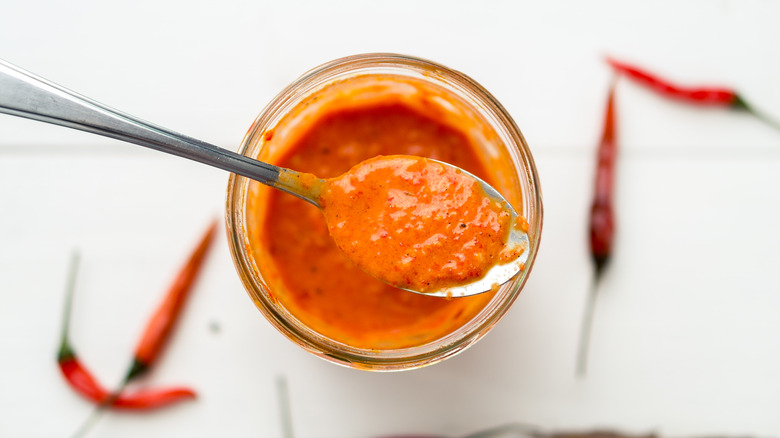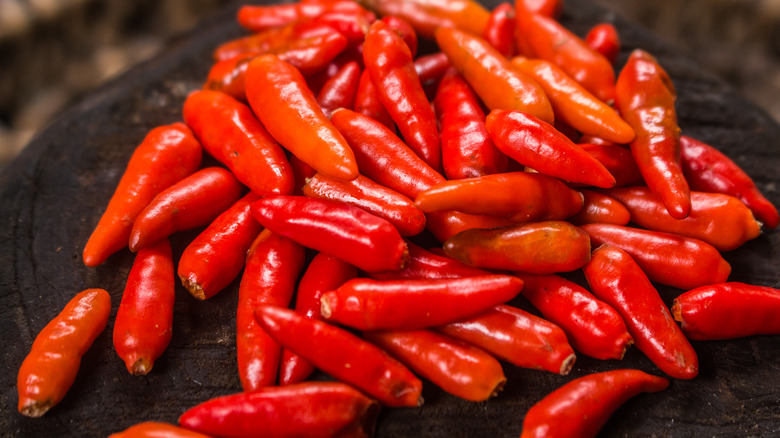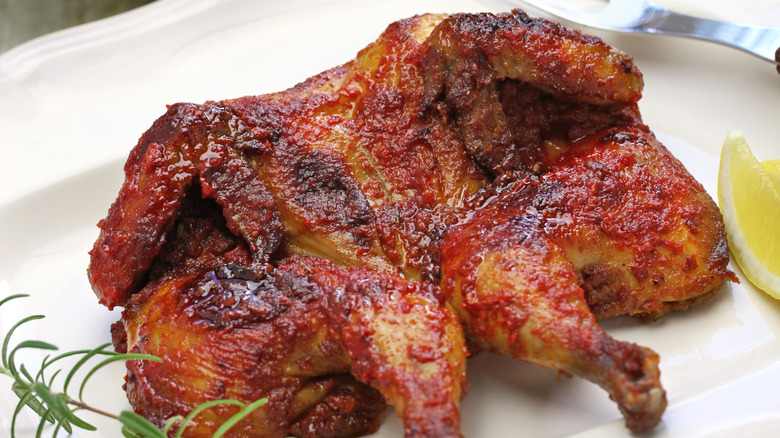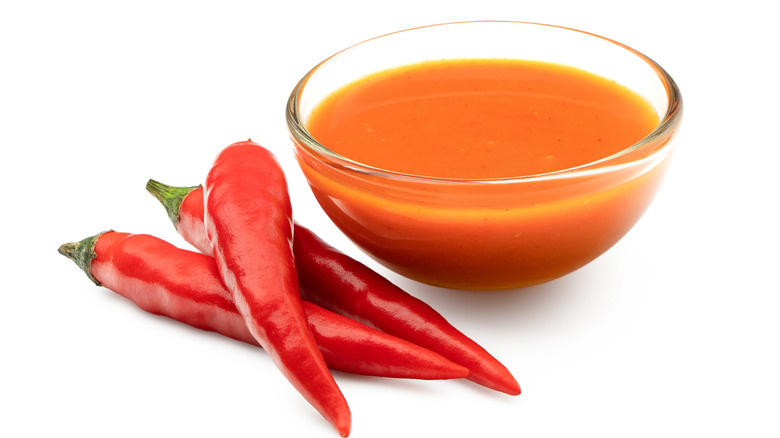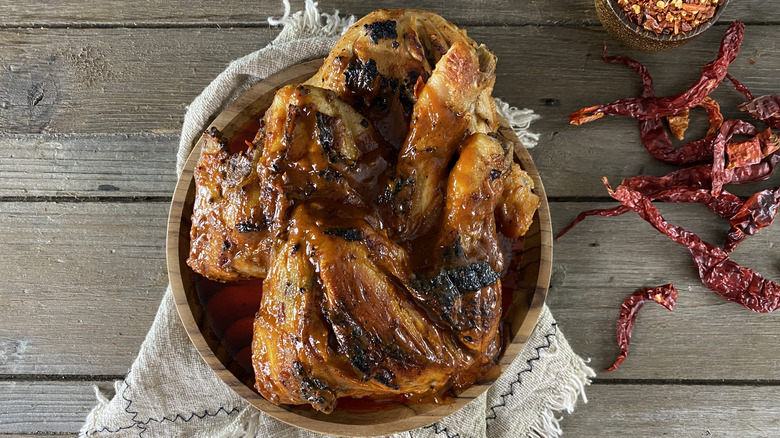What Makes Piri-Piri Sauce Unique?
Sometimes just a droplet of hot sauce is all that's needed — but what a difference it makes. Increasingly, palates are craving the burn, with the global hot sauce market expected to grow by 7% annually to $4.72 Billion in 2029. Yet, while there are many global variations of bottled heat, the top sellers are surprisingly undivided. Familiar favorite Tabasco claims nearly a quarter of global sales, reports Fortune Business Insights. While there's nothing wrong with this vinegar-based sauce, don't feel intimidated to experiment with other international options.
Exhibiting varying textures, like sticky gochujang, or creamy aji, they can be used in ways other than a drop on top. For an especially aromatic kick, seek out piri-piri, a delectable Afro-Portuguese hot sauce. Used to marinate chicken for up to 24 hours, this oil-based sauce is loaded with spicy peppers, garlic, paprika, lemon, and other herbs, per Taste Atlas. Now popular in South Africa, Canada, and Australia, it's easy to see why — piri-piri delivers a flavorful hit.
What is piri-piri sauce?
Alternatively called peri peri, this aromatic sauce combines many tastes– sweet, tangy, salty, and spicy. While its components vary, its pepper base is the one unchanging addition. Piri-piri uses African bird's eye chilies — which definitely pack a punch. Typically carrying around 150,000 Scoville units, they make piri-piri consistently spicy, although the intensity depends on the creator. Other common components in this sauce include oil, vinegar, garlic, onion, lemon, paprika, oregano, and tarragon, reports Today.
Piri-piri does not have a fixed recipe or ratio — it ranges from simple to elaborate. Nando's is one of the most popular bottled varieties, and it keeps it simple with salt, garlic, lemon, and vinegar as the only flavorings, via Nando's. Famed Lisbon chef José Avillez adds bay leaf, shallots, and thyme, and Portuguese taverns often make a whiskey-based sauce to soften the peppers. Variations are usually regional, like the coastal town of Guia, which is especially famed for its closely guarded recipe for piri-piri, explains Culinary Backstreets.
The origins of piri-piri sauce
Although associated with Portugal, the sauce actually originated alongside Portuguese settlers in Africa, likely Angola, Mozambique, or South Africa. Its globalized history arrived in the cargo of sailors who carried peppers from the New World to Africa. Born of globalized movement, even piri-piri chicken, now an iconic dish, only reached mainland Portugal in the 1960s, explains We Travel Portugal. Piri-piri's roots in Africa are evident both from its name, which translates to "pepper pepper" in Swahili, and core chili, which emerged after sailors brought peppers to East Africa.
Both Portuguese settlers and local East Africans started integrating the chili into their food, mixing it with other components to create the sauce. In the second half of the 21st century, these African nations fought for independence from Portuguese rule. As a result, the white settlers fled back to Portugal and neighboring countries like South Africa. They brought the sauce with them, creating an international condiment consumed across continents, per Thrillist.
How to make piri-piri sauce
This tasty hot sauce starts with a handful of chilies. Leite's Culinaria recommends using just enough to generate some heat but not enough to override other flavors. Since piri-piri chilies can be hard to find stateside, you can substitute Thai bird's eye chilies or cayenne peppers. Then, blend the chilies with up to a cup of olive oil, as well as flavorings like lemon, garlic, and salt. The mixture is allowed to sit in the fridge for 24 hours before it's ready to serve.
The resultant texture highly varies based on recipe and preference. Some, like this rendition by Chili Pepper Madness, add up to a pound of chilies to only half a cup of oil, generating a thicker, spicier sauce. For the aromatics, the sky's the limit, with the aforementioned denser sauce incorporating fresh herbs, while dried spices, spirits, and even zests are common in other versions. To ensure a long shelf-life, make sure to add an acid, which will allow piri-piri to keep for a few months.
How to use piri-piri sauce
There's a good reason piri-piri chicken is the sauce's most notable application — the pepper mixture works wonders as both a marinade and topping for chicken. The sauce's transformative softening qualities also extend to other proteins, like shrimp (via Salt and Wind), pork tenderloins, or wings. Or, it can be added to beverages, like for the spicy zing in a bloody mary, or as a vehicle for spice in a chavela, per Allrecipes.
Piri-piri rivals sriracha in versatility, so consider using it in place of another hot sauce. The sauce adds complexity to everything from a tomato sauce, mayonnaise spread, or simply a drizzle on top of a noodle bowl or eggs notes Epicurious. And while reaching for bottled sauces can be tasty, in Portugal, homemade is the norm. Diners expect restaurants to have their own varieties rather than using a manufactured sauce, reports Portugal News. So assemble some piri-piri peppers, aromatics, and blend. Before long, your version will become a dependable tableside condiment.
